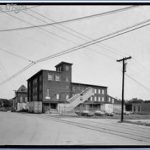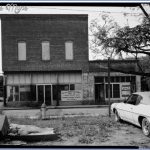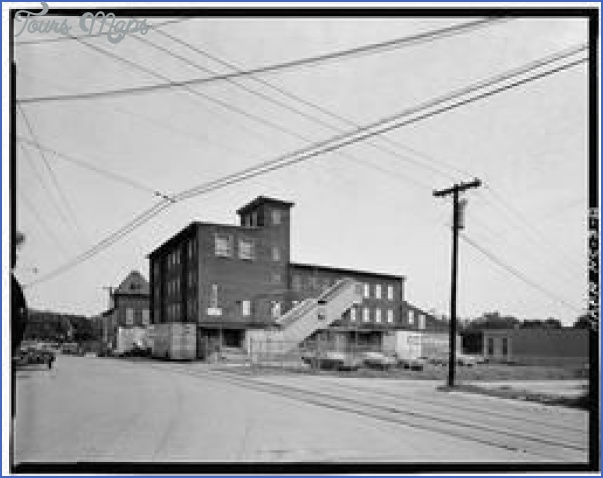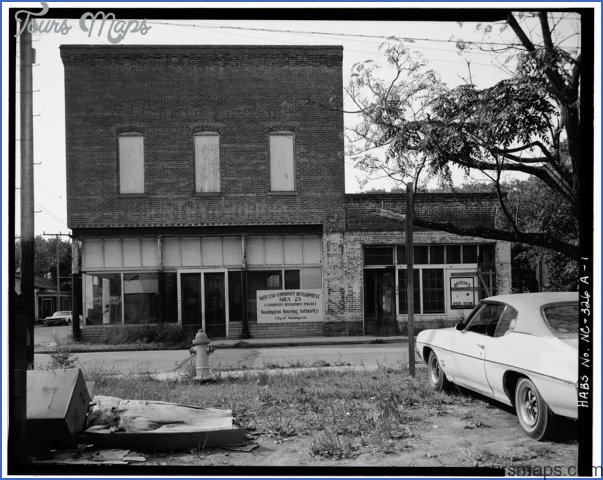Native American Heritage
MORROW MOUNTAIN, TOWN CREEK, AND ELLERBE
Company towns sprouted up all over North Carolina during the nineteenth century. Built mostly by timber, mining, and textile companies, they prospered until resources were depleted or the markets changed. Most became ghost towns and faded into obscurity. Badin is unique. It didn’t sprout until well into the twentieth century, among the last of North Carolina’s company towns. And despite the recent closing of its benefactor, Badin remains a delightful village with an interesting collection of historical architecture.
A French aluminum company started Badin in 1912. The company came here to capitalize on the enormous hydroelectric potential of the Narrows of the Yadkin, where the Yadkin River narrowly squeezed between rock walls and dropped some ninety feet in a mile. World War I forced the company to sell the project to Aluminum Company of America, which completed the dam (and eventually built three more dams on the Yadkin) and the town. But the French influence had been established, evidenced today in the distinctive architecture of the town, and also in its name, after the president of the French company, Adrien Badin. In 1983, the National Register of Historic Places recognized Badin as a National Historic District.
The history of the Badin region goes far deeper than house styles. Just outside the town, an archaeological site recognized as a National Historic Landmark overlooks the Yadkin River. Called Hardaway, the site has relinquished nearly two million Native American artifacts, making it among the most significant archaeological discoveries in the nation.
As you might expect, access to the Hardaway site is strictly prohibited. But nearby is another significant archaeological site that is open to the public. Morrow Mountain State Park lies along our route, just down the road from Badin. At Morrow Mountain you can camp, hike, fish in Lake Tillery, take a dip in the swimming pool, picnic, and watch the sun setting from the summit of the park’s namesake all typical activities in our state parks.
What sets this park apart from most others is its archaeological history. Countless rock shards cover the summit of Morrow Mountain, the remains of an ancient quarry utilized by Native Americans. Modern analysis shows the rock to be metarhyodacite, more commonly known as rhyolite. Indians prized the rhyolite as their material of choice for arrowheads, scrapers, axes, and other stone tools. They came from all over the region, some traveling considerable distances, to obtain the material. No evidence exists that Indians had permanent settlements at Morrow Mountain. Most likely they only quarried the rhyolite, breaking it into manageable chunks called cores and hauling those away for further processing. Most of the artifacts at the Hardaway site, for example, were made from Morrow Mountain rhyolite. How big was this operation? One geologist suggests that Morrow Mountain is covered with millions of tons of quarrying debris! You can easily see it for yourself by hiking the Mountain Loop Trail encircling the summit. Remember that everything is protected within the state parks. Collecting is strictly prohibited.
Start out in the town of Badin, near Albemarle. Head south on Valley Drive. Drive 2 miles to Morrow Mountain State Park. Visit the park, then continue 3 miles on Valley Drive and turn left onto NC 73. Drive 17 miles, then turn left onto Indian Mound Road. Drive to Town Creek Indian Mound, then backtrack to NC 73 and turn left. Drive 11 miles, then turn right onto U.S. 220 south. Drive 1 mile to Ellerbe, then turn right onto Church Street. Follow it to the Ranking Museum. (45 miles)
Fishermen try their luck on Lake Tillery early in the morning.
Wall paintings decorate the interior walls of the Temple Mound hut at Town Creek Indian
Mound State Historic Site.
After whetting your archaeological appetite at Morrow Mountain, it’s time for the main course at Town Creek Indian Mound. Like Hardaway, the Town Creek site is nationally significant for contributing to our understanding of Native American culture. The site served as a political and ceremonial center for Native Americans during the period archaeologists call the Pee Dee Culture, beginning around AD 1200. Unlike Hardaway, however, Town Creek Indian Mound is open to the public as a state historic site. Visitors can tour the reconstructed Major Temple atop an earthen mound, a smaller Minor Temple, and a burial house, all surrounded by a log palisade. The visitor center features interpretive displays and a slide program.
Now that you’ve had the main course, it’s time for the dessert. For Native American and early American history buffs, it doesn’t get much sweeter than the Ranking Museum of American Heritage in Ellerbe. The museum displays a remarkable collection from the fields of paleontology, natural history, regional cultural history, and general Americana. But most impressive are its archaeology displays, perhaps the finest in the state open to public viewing. The museum makes a fitting conclusion to our route of Native American influence in the Uwharrie Mountains.
A stockade fence frames a view of the Temple Mound at Town Creek Indian Mound State
Historic Site.
Swiss cannons overlook the waterfront of Edenton Bay in Edenton, North Carolina. The cannons were brought from France for use in defending North Carolina during the
Revolutionary War.
Sieburg-Baker, Library of Congress Photo Gallery
Maybe You Like Them Too
- The Best Cities To Visit in The World
- World’s 10 Best Places To Visit
- Coolest Countries in the World to Visit
- Travel to Santorini, Greece
- Map of Barbados – Holiday in Barbados




